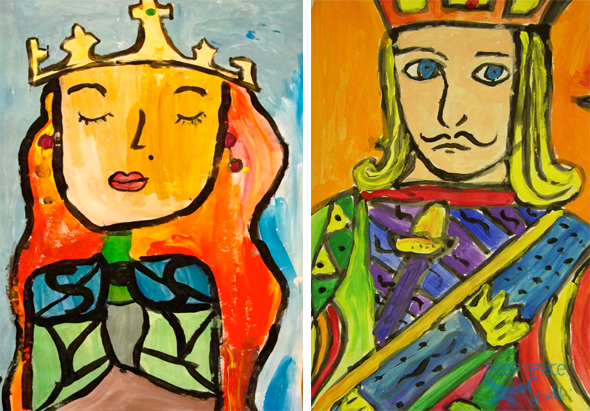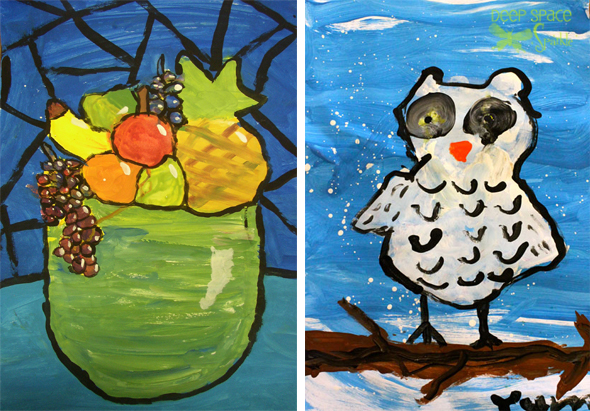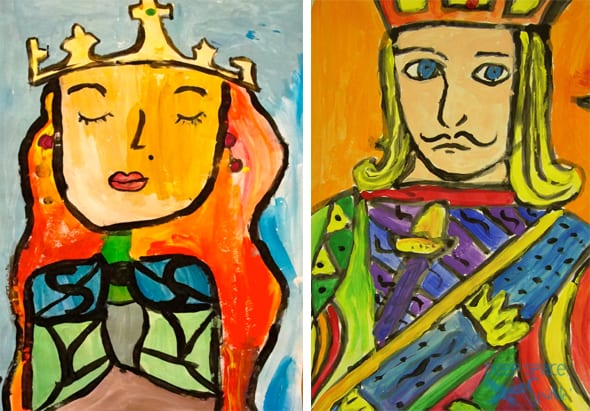Double loading is a painting technique I use in all my art classes. It’s super easy, eliminates some common painting problems like using too much water, plus it’s truly beautiful.
After many requests asking me to explain how I teach this cool technique, I have finally done it! Here is a short video (1:45 seconds) showing how the the process works…
This is my absolute favorite tempera paint technique. The name comes from the simple description of adding more than one color of paint to a brush. Most lessons ask that a child dip their brush into a single color then paint onto a piece of art paper. Or instructions ask the student to mix paint onto a palette to create a color. Double-loading is a bit of a hybrid.
The idea is to not only create beautiful, interesting colors but the benefit is that it saves a whole lot of time. Mixing paint on a palette is a rewarding experience but it can take a while to complete a painting. When time is not on your side and you have 30 kids to move through the painting process, the double-loading technique is your best friend.
Here’s what to do:
- Start with 3-5 colors of paint. I like to include white into this mix.
- Dip paint brush into one color (say red) then scoop up a tiny amount of another color (say white). You will see two colors on the brush.
- Brush paint onto a paper surface noticing how the colors appear on the paper. The more times you brush the paint onto the paper, the more it will blend. Sometimes it’s nice to leave the application alone so you can see the striped effect of the two colors.
- Try loading the brush with three colors.
- The tip for making this technique work really well is not to use too much water in between paint colors. The idea is to have remnants of color already on your brush so that after dipping into a paint color, a new color appears.
Here are some art lessons that use the double-load technique:


Here are a few art lessons that use the double-loading technique…
Sixth Grade Rouault-Inspired Kings & Queens
Fifth Grade Stained-glass Fruitbowls
New to teaching art in the classroom? Download my free classroom art teachers toolkit by clicking the yellow box below!














I love the video! Straight to the point with lovely music in the background 🙂
Oh my goodness- that is the coolest!!! Linking to you this weekend in my “recommended reads/links.” Something so simple produces such lovely results. (And cool video, by the way!) 🙂
Sorry to comment again, but I just thought of a question. How do you manage the messy pallets with classes coming in and out? I assume you have to clean them after each period? Do you let students rinse and refill?
Spelling correction (because I am OCD that way)- palettes, not pallets.
I swear this is my final remark on this website today.
Re: Palettes. I generally don’t do a whole day of double-loading painting projects and at most will have one back-to-back classes that will do similar projects. So, all I do is squeeze more paint directly on top of the messy paint. Because the kids don’t swirl the paint in the palettes, only dip and scoop, the layering of paint in this manner works really well. Also, the students share palettes: 1 palette per table group of 4-6 kids.
At the end of the day I do have lots of messy palettes!
Thanks!
What are the brushes you are using in this video & where can you get a great deal on them?
Hi Heather,
I used Royal-Langnickle brushes. You can find all the art supplies with links here: https://www.deepspacesparkle.com/resources/
I use ice cream bucket lids…Gallon lids… I keep them at end of the year ice cream socials at school and church. They can have more tempera poured on top of each tiny quarter sized pile of tempera also…
Then when dry, and the palettes are no longer needed, they flake and can be tipped into trash can before rinsing.
These can also be used as “Yarn Barns.” Drill or trim 3-4 small holes in the top of the lids, thread yarn ball end of yarn through top of the lid, put the lids back on the buckets. Only teacher enters the “barns” to “fix” any yarn that is tangled. Also…keep one arm length hanging OUT of the top at all times…so the yarn doesn’t fall back into the bucket.
Love the “yarn” tip!
Love the video!. I’m interested in the answer to Susan’s palette question! I am using cheap paper plates so clean up is quick. If I had my older kids in the afternoon, I would have them help clean…but I have 2nd, 1st and kinders at the end of the day. Paper plates seem like they might get too dry, too quickly using this method?
Great video. Always trying to encourage kids to be “painterly” and this is a great way of showing them how.
I use the double dip method a lot with my students, and we use paper plates! I find that two or three classes in a row can use the same plate if I freshen it up with a new squeeze in between classes, but I really emphasize that students should just dip and paint, not mix the colors together on the plate (because then it takes away other people’s choices).
If I’m just using a few similar colors for multiple classes (like brown, black, and white) I will sometimes wipe the globs off at the end of the day into the garbage and let the plates dry out. These I can reuse about three times before they’re dead. (This only really works with the wax coated plates, the waxless plates I don’t bother to reuse for more than one day.)
If we’re using a bunch of colors I’ll put warm colors on half the tables, and cool colors on the other half, and have students move to whatever table they need to be at.
Hi Patty,
Thanks for the great tutorial. I got inspired and tried this technique with my summer art camp kids and they loved it!
I posted about it on my blog
http://www.saythingswithcolor.com/2014/08/direct-painting-with-kids.html
Thanks and keep up the great work!
Alia
its fantastic idea but could i use the same tips with acrylic or oil paint?
I would try…I’ve never worked with oils with children 🙂
Art you using tempera for the double loading?
Yes. Liquid tempera paint.
Thanks! This looks very helpful and I look forward to the newsletter. Throughout the year.
It’s been a long time since someone left a comment, I still love going back to videos for refresher <3
Fantastic web site! Thank you!
I will be teaching my great nephew art classes this summer. He is six. Any web page or view first or recommendations please?
Gratefully! Dan
Sounds like a fun rewarding way to pa Jj nt!
How great that you talk about double loading, and that it creates beautiful colors and saves a lot of time. I am redecorating my living room and want some beautiful artwork. I will include a scenic New Mexico acrylic painting for this. https://agnescrowleyartist.com/acrylics-portfolio/new-mexico
Very nice
This is spectacular! Thank you so much for the tutorial!